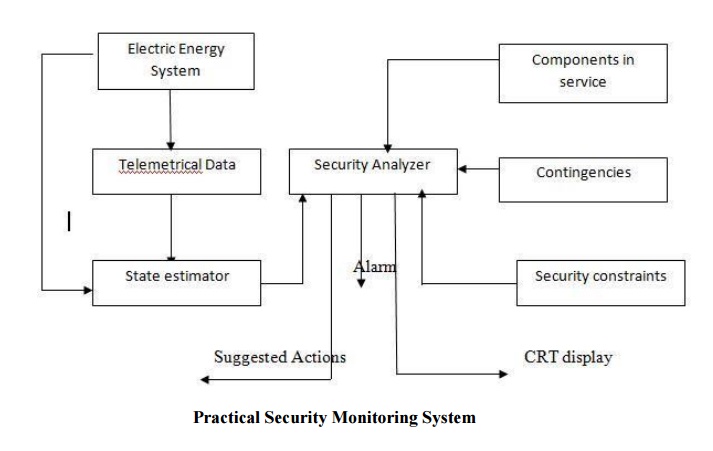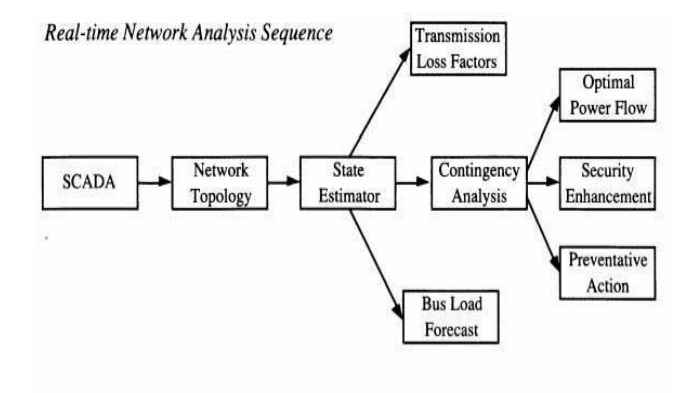Chapter: Power System Operation and Control : Computer Control of Power Systems
Security Analysis & Control
SECURITY ANALYSIS & CONTROL:
Security monitoring is the on line identification of the actual operating conditions of a power system. It requires system wide instrumentation to gather the system data as well as a means for the on line determination of network topology involving an open or closed position of circuit breakers. A state estimation has been developed to get the best estimate of the status .the state estimation provides the database for security analysis shown in fig.5.6.
· Data acquisition:
1. To process from RTU
2. To check status values against normal value
3. To send alarm conditions to alarm processor
4. To check analog measurements against limits.
· Alarm processor:
1. To send alarm messages
2. To transmit messages according to priority
· Status processor:
1. To determine status of each substation for proper connection.
· Reserve monitor:
1. To check generator MW output on all units against unit limits
· State estimator:
1. To determine system state variables
2. To detect the presence of bad measures values.
3. To identify the location of bad measurements
4. To initialize the network model for other programs

Security Control Function:
Ø Network Topology processor-mode of the N/W
Ø State estimator.
Ø Power flow-V, δ,P,Q.
Ø Optimal power flow.
Ø Contingency analysis.
Ø Optimal power flow.
Security enhancement-existing overload using corrective control action. Preventive action.
System Security
1. System monitoring.
2. Contingency analysis.
3. Security constrained optimal power flow
Security Assessment
Ø Security assessment determines first, whether the system is currently residing in an acceptable state and second, whether the system would respond in an acceptable manner and reach an acceptable state following any one of a pre-defined contingency set.
Ø A contingency is the unexpected failure of a transmission line, transformer, or generator.
Ø Usually, contingencies result from occurrence of a fault, or short-circuit, to one of these components.
Ø When such a fault occurs, the protection systems sense the fault and remove the component, and therefore also the fault, from the system.
Ø Of course, with one less component, the overall system is weaker, and undesirable effects may occur.
Ø For example, some remaining circuit may overload, or some bus may experience an undervoltage condition. These are called static security problems.
Ø Dynamic security problems may also occur, including uncontrollable voltage decline, generator overspeed (loss of synchronism), or undamped oscillatory behavior
Security Control
Ø Power systems are designed to survive all probable contingencies.
Ø A contingency is defined as an event that causes one or more important components such as transmission lines, generators, and transformers to be unexpectedly removed from service.
Ø Survival means the system stabilizes and continues to operate at acceptable voltage and frequency levels without loss of load.
Ø Operations must deal with a vast number of possible conditions experienced by the system, many of which are not anticipated in planning.
Ø Instead of dealing with the impossible task of analyzing all possible system states, security control starts with a specific state: the current state if executing the real-time network sequence; a postulated state if executing a study sequence.
Ø Sequence means sequential execution of programs that perform the following steps:
1. Determine the state of the system based on either current or postulated conditions.
2. Process a list of contingencies to determine the consequences of each contingency on the system in its specified state.
3. Determine preventive or corrective action for those contingencies which represent unacceptable risk.
Ø Security control requires topological processing to build network models and uses large-scale AC network analysis to determine system conditions.
Ø The required applications are grouped as a network subsystem that typically includes the following functions:
Topology processor:
Processes real-time status measurements to determine an electrical connectivity (bus) model of the power system network.
• State estimator:
Uses real-time status and analog measurements to determine the „„best‟‟ estimate of the state of the power system. It uses a redundant set of measurements; calculates voltages, phase angles, and power flows for all components in the system; and reports overload conditions.
• Power flow:
Determines the steady-state conditions of the power system network for a specified generation and load pattern. Calculates voltages, phase angles, and flows across the entire system.
Contingency analysis:
Assesses the impact of a set of contingencies on the state of the power system and identifies potentially harmful contingencies that cause operating limit violations.
Optimal power flow: Recommends controller actions to optimize a specified objective function (such as system operating cost or losses) subject to a set of power system operating constraints.
• Security enhancement:
Recommends corrective control actions to be taken to alleviate an existing or potential overload in the system while ensuring minimal operational cost.
• Preventive action:
Recommends control actions to be taken in a “preventive” mode before a
contingency occurs to preclude an overload situation if the contingency were to occur.
• Bus load forecasting:
Uses real-time measurements to adaptively forecast loads for the electrical connectivity (bus) model of the power system network
• Transmission loss factors:
Determines incremental loss sensitivities for generating units;
calculates the impact on losses if the output of a unit were to be increased by 1 MW.
• Short-circuit analysis:
Determines fault currents for single-phase and three-phase faults for fault locations across the entire power system network.


Related Topics